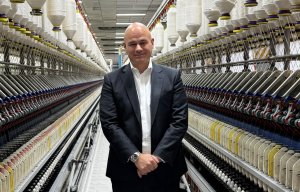
DNA tagging for C&A’s organic cotton
Opinion


A significant shift in the established textile manufacturing and supply chains is now underway, as witnessed during last week’s Heimtextil show.

16th January 2017
Adrian Wilson
|
Frankfurt
 “Everything that can become digital, will become digital.”
“Everything that can become digital, will become digital.”
This was just one of the assertions – he’s rather good at them – made by Mike Horsten, general marketing manager for Mimaki, in a presentation during last week’s Heimtextil show in Frankfurt.
It does appear that a significant shift in the established textile manufacturing and supply chains is now underway, and advances in digital printing are certainly a driving factor. These changes apply not only to fast fashion, but to home furnishings and to technical textiles too.
By coincidence or not, during the show, Amazon announced that it would invest significantly in the Israel-headquartered digital printing equipment manufacturer Kornit.
Following previous machine purchases, Amazon has selected Kornit to supply it with a large number of on-demand textile production systems. Going further, Amazon will purchase around $38 million in Kornit shares over the next five years.
Kornit already has more than 1,200 of its digital printing machines installed worldwide, with the majority of them being direct-to-garment systems. Its Allegro unit, however, is a roll-to-roll system that can accommodate virtually any fabric, and its advantages are obvious.

“It’s flexible, simple, there’s little investment risk and it wastes way less energy and water than analog production,” said Merav Zimerman, Kornit’s product marketing manager. “It’s possible to print endless designs in continuous mode and we have customers running machines 24 hours a day on orders for just one or two metres, with up to 50,000 designs being cut and mailed directly to people.”
The technology, she added, is leading to order activated production.
“Manufacturers and retailers are both moving from supply and demand to demand and supply, and to purchases before production,” she said. “Imagine how much money both manufacturers and retailers can save.”
Meanwhile, around 120 Mimaki digital printers are now responsible for every garment being produced by Inditex with a Zara label on it.
As far as home textiles are concerned, Mike Horsten provided some surprising statistics. The global textile market, he said, is now worth an annual $633 billion, with 58% of this going into apparel, 24% into technical textiles and 18%, or around $114 billion, into home textiles.

In 2015, the European Union imported home textiles worth €17.8 billion, with 49% of it coming from developing countries. Yet only 1% of the home textiles produced in China are exported to the EU.
“Supplies by us to China have increased by 20% and they are now buying more from us than we buy from them, because people want things faster and personalised,” he said. “The business model is changing and the value chain is being reset.”
This change was also noted at a press conference for the forthcoming Techtextil and Texprocess 2017 exhibitions.

Manfred Junkert of textile+mode provided an overview of Germany’s textile and fashion industry, which comprises some 1,400 companies employing 132,000 people and has a turnover of €32 billion, around 60% achieved by textiles alone.
“Digitisation is perhaps the greatest challenge and the biggest opportunity facing our industry for many decades,” Junkert said.
“At Texprocess 2017 in particular, we will see the growing integration of design, processing and logistics of both clothing and technical textiles,” added Elgar Straub, managing director of VDMA Textile Care, Fabric and Leather Technologies. “This is resulting in a higher level of automation, shorter reaction times, the highest flexibility and the greatest possible efficiency. It is resulting in the reshoring of the manufacture of high-priced products and will create new jobs, but there will be a change to the way in which work must be structured.”

Digital printing, he added, is now having a major impact, and at Texprocess 2017, the digitised combining of the printing and cutting stages will be the next move forward to be demonstrated in the manufacture of both clothing and shoes, and technical textile and nonwoven products.
Mimaki was also involved in the ‘Digital Textile Micro Factory’ which ran throughout the Heimtextil show to demonstrate the ease with which such operations can be established.
“We set it up in just 24 hours to demonstrate what can be done simply and easily and achieve instant differentiation in the market,” said Mike Horsten. “Exclusivity is now the margin maker. Will digital replace analog? Yes it will.”
Heimtextil 2017 attracted 2,963 exhibitors from 67 countries to Frankfurt last week.

Business intelligence for the fibre, textiles and apparel industries: technologies, innovations, markets, investments, trade policy, sourcing, strategy...
Find out more